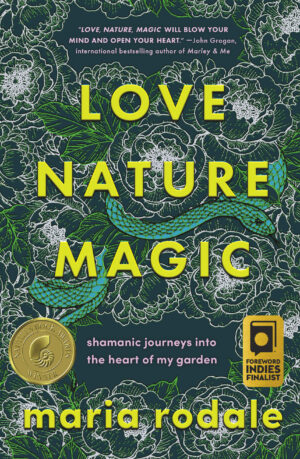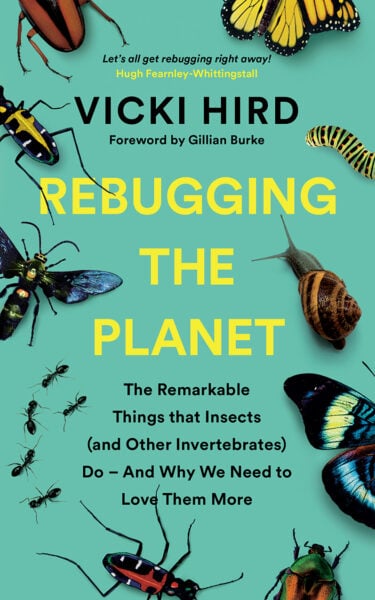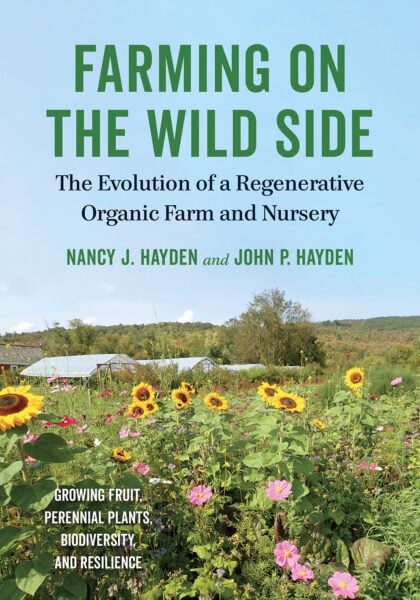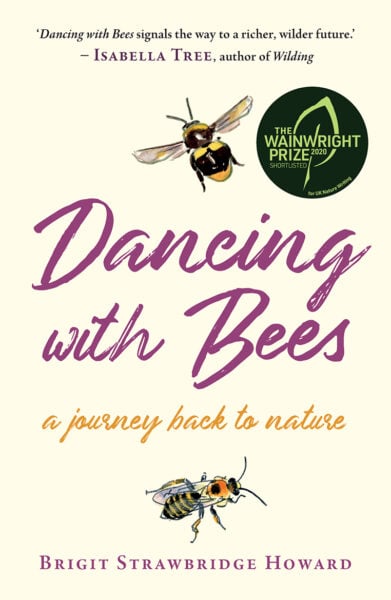How Did the Lanternfly Become the Enemy?
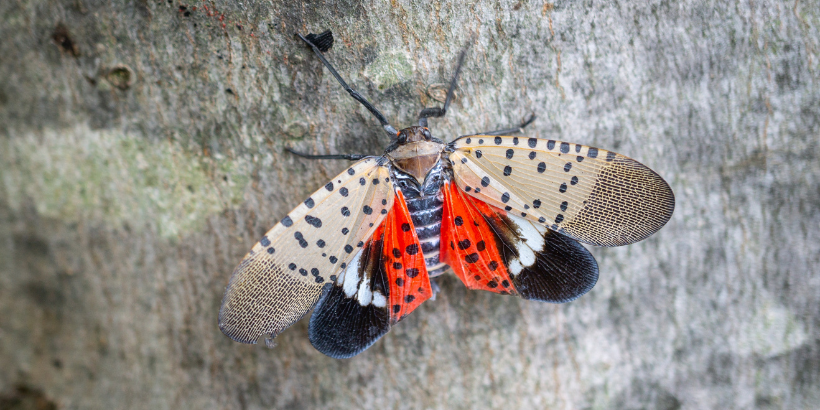
We’ve been told to destroy any lanternflies because they’re “invasive and destructive” to our environment. In reality, these small pests are simply living like any other insect would — so why is the lanternfly under attack?
The following is an excerpt from Love, Nature, Magic by Maria Rodale. It has been adapted for the web.
Lanternfly: The Way to Heaven Is Through Joy
JOURNEY: AUGUST 14, 2021
Picture this: I filled a bucket with hot water, vinegar, soap, and cooking oil and carefully walked out to a young tree of heaven, which was the brand-spanking-new home of spotted lantern flies, an “invasive invader” from Asia. The sapling was about fifteen feet tall, weedy, with leaves that looked like ferns. My goal was to cut down the tree (with a handsaw, mind you), but first I wanted to get the giant insects off the tree and kill as many of them as possible in one fell swoop. Because we had been told over and over: If you see them, kill them. They are invasive. They are destructive and have no known predators in North America.
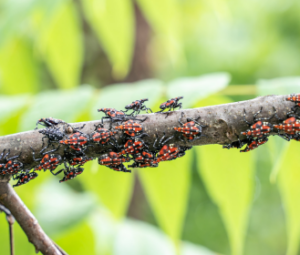 The laternflies were lined up together facing upward on the trunk of the tree. From a distance they look like bark—a part of the tree— but closer inspection reveals them as a swarm of bugs. When their wings are closed, they are the same color as the tree trunk. But when they fly you see their red-and-white wings in a whirl of color. Each insect is about an inch long.
The laternflies were lined up together facing upward on the trunk of the tree. From a distance they look like bark—a part of the tree— but closer inspection reveals them as a swarm of bugs. When their wings are closed, they are the same color as the tree trunk. But when they fly you see their red-and-white wings in a whirl of color. Each insect is about an inch long.
I flung the water at the tree and suddenly about four hundred lantern flies erupted in every direction, including straight toward my face. They don’t bite, but they are big. I SCREAMED! (My kids will tell you I’m a screamer.) I ran as fast and far as I could. I felt myself starting to fall right as I reached my macadam driveway, which is truly not an ideal place to land.
Somehow, I managed to stumble all the way across the driveway without falling until I got to the grass on the other side. There I tumbled down inelegantly, still holding the bucket, laughing so hard, only slightly injured, and triumphant that there was still an inch or two of my nontoxic death fluid in the bucket. It was my version of a slow-motion English Premier League football fall (officially known as a “dive”). I was very proud of it.
Returning to the tree, I started stomping on the still quivering bugs, determined to obliterate all of them. After I was satisfied that most of them were dead, I sat on a rock and started to saw through the trunk. The tree of heaven is a weedy tree—the kind that grows through cracks in the pavement in cities. It’s a prolific producer of new sprouts from its seeds. I had cut down a large tree of heaven about ten years ago, and it is still one of the most com- mon “weeds” I pull from my garden.
The sapling I was sawing was about six inches in diameter—a “weed” that got away. Sawing with a handsaw takes patience and, since I’m getting older, a break or two to rest. A third of the way through, I thought about calling someone with a chain saw to help. But I persisted. Two-thirds of the way through, I took another break and sat on the grass and pondered this spotted lanternfly.
Is The Lanternfly Actually Invasive?
It probably didn’t choose to come to this continent. Maybe it got packed into a crate of stuff that someone was sending by accident. It could be a new military tactic sent by the government of China to destroy the United States, but probably not. More likely it snuck into a case of cheap merchandise headed to a Dollar Store. If it wasn’t labeled as a terribly invasive species, it might even be beautiful. Even though its eyes are bright red and scary.
But it was while stomping a few of them to death that I thought of those videos you see on social media—you know the ones—of a man, maybe a cop or a white supremacist, stomping and kicking a person who is on the ground huddled in a ball and crying for mercy.
Wait. Is that what I was doing? How was I different? I was aggressively killing something “that doesn’t belong here” even though it was no true harm to me. Because I was told “If you see them, kill them. They are invasive!”
We went through this a decade ago with the brown marmorated stink bug, another insect accidentally imported to North America from Asia and first spotted in the part of Pennsylvania where I live. But that was slightly different because those stink bugs would show up inside the house. I remember one warm day in late September when I vacuumed up thousands of them from my bedroom. Not cool. That’s breaking and entering, if you ask me. (But we are friends now, Stinky and me.)
The spotted lanternflies weren’t in my bedroom, though. They were in my front yard, which, let’s face it, is really the woods. There is no controlling The Woods.
I finished cutting down the tree and walked back into my house, feeling slightly ashamed of myself. But I also appreciated the insight into my own behavior and the way in which it is so easy to get caught up in frenzies and swarms of actions that don’t make much sense. I consider myself a peaceful, nature-loving human, but even I could turn vicious given the right circumstances.
How Lanternflies Became The Enemy
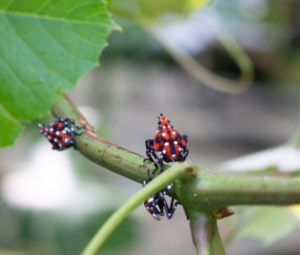 How and why does that happen? I’m not sure. Ultimately most of us are immigrants. And many of us and our ancestors were vilified on arrival. Some arrived voluntarily, others involuntarily. But no matter when or who, the story is the same.
How and why does that happen? I’m not sure. Ultimately most of us are immigrants. And many of us and our ancestors were vilified on arrival. Some arrived voluntarily, others involuntarily. But no matter when or who, the story is the same.
Within a few years of lanternflies’ initial wave of immigration to the United States—and of my attempt at their massacre—they seem to have settled into the environment, just like the stink bugs. I rarely see them anymore.
That could be because people expended so much time, energy, and toxic spray trying to kill them—I hate to think of the pesticide residues left behind and what effects they are having on our bodies. Or perhaps the insects have assimilated and now they are one of us, part of that old American melting pot, which we once celebrated as our special gift to the world, as that characteristic that makes our culture so unique.
I watch the culture wars of today with a sense of confusion and sadness. People on all sides seem to throw whatever horrible words they can at each other without showing any desire to understand, listen, or resolve differences. It’s exhausting and mean.
With that sorrow weighing me down, and the lingering memory of my own attack on the lanternflies in the tree of heaven, I felt compelled to journey to ask Lanternfly what it all means, even though I’m a little creeped out at the idea of journeying to talk to insects.
I don’t like to journey when there are other people in my house, and my kids were staying with me for two weeks of summer fun. Halfway through those two weeks my beloved but elderly cat Pumpkin died. I decided to wait until everyone left before I would try to visit with Lanternfly. I found myself hoping that Pumpkin would show up in my journey too.
On an early Saturday morning, in my now-empty house, I smudged with sage from my own garden, opened sacred space, and lay down on my magic blanket.
The drumming started.
A Joyous Journey: Communicating With The Lanternfly
I opened a wooden door in a tree and entered a meadow and woods. I smelled incense and felt that I was somewhere in Asia (in the distance I could see a temple). I was very small and hidden among the grasses. I had become a lanternfly. A little Asian girl leaned closer to play with me. I hopped, and she laughed and hopped after me. (During one nymph stage of a lanternfly’s development, before it grows wings, it is a bright red jumping bug with white and black spots. But even when they are mature, lanternflies hop as much as they fly.)
Lanternfly spoke: “In Asia we are symbols of joy. Children love to play with us since children do not judge. They have to be taught to judge.” I saw the small child hopping after a lanternfly nymph and giggling.
“We came to America as eggs on wood. Apparently Americans need more joy. But we were met with anger, fear, and hatred.” I heard the word “killjoys” whispered around me, as if the lanternflies were accusing Americans under their breath of being destroyers of pleasure and no fun at all.
“We line up on trees of heaven to tell you that the way to heaven is through joy!”
At this point in the journey, I started sobbing. Of course. How had I not known this about lanternflies before? Even calling the tree of heaven a “junk tree,” as I had, seemed horribly wrong.
“Our purpose is to bring joy. In Asia we are considered beautiful.”
Then Pumpkin showed up, nudging me and licking the tip of my nose like she used to. She proudly showed me her baby angel wings. She said, “Pets exist to teach you humans how to love—but you need to learn to share that love with other humans. We all have a purpose, and joy exists when everyone and everything is living fully in their own unique purpose.”
A New Perspective On A “Pesky” Insect
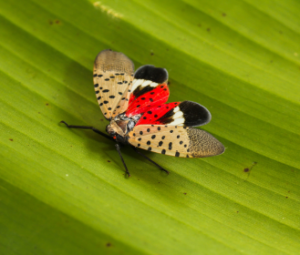 I came out of the journey stunned and humbled. In retrospect these things seem so simple and obvious, and yet we are so blind to them. (I was so blind to them.) It takes a journey for me to see things as they really are, not just as I imagine them to be.
I came out of the journey stunned and humbled. In retrospect these things seem so simple and obvious, and yet we are so blind to them. (I was so blind to them.) It takes a journey for me to see things as they really are, not just as I imagine them to be.
The tree of heaven, also known as the Chinese sumac, the stinking sumac, or stink tree, was brought to the United States from China in the late 1700s as a shade tree. It was popular in cities because it was so easy to grow. In fact, it’s the tree that is featured in the novel A Tree Grows in Brooklyn by Betty Smith:
She looked down into the yard. The tree whose leaf umbrellas had curled around, under and over her fire escape had been cut down because the housewives complained that wash on the lines got entangled in its branches. The landlord had sent two men and they had chopped it down.
But the tree hadn’t died . . . it hadn’t died.
A new tree had grown from the stump and its trunk had grown along the ground until it reached a place where there were no wash lines above it. Then it had started to grow towards the sky again.
Annie, the fir tree, that the Nolans had cherished with waterings and manurings, had long since sickened and died. But this tree in the yard—the tree that men chopped down . . . this tree that they built a bonfire around, trying to burn up its stump—this tree lived!
It lived! And nothing could destroy it.
I went outside to Pumpkin’s grave to thank her for showing up in my journey. There is a beautiful rock to sit on there, placed by my son-in- law, an immigrant. And so I sat, just absorbing this new insight into life and feeling very grateful. After a few minutes I looked down at the ground. There, on a small blade of grass, pointing toward heaven, was a single lanternfly.
Thank you, Lanternfly.
Recommended Reads
Plants & Pests: Will Bonsall’s Advice on "Wee Beasties" in the Garden
Recent Articles
Garden strawberries are excellent for both covering the ground and for growing fruit. If you’re planning out a forest garden, or are just looking for a plant to use as ground cover, strawberries are a great option. The following is an excerpt from The Home-Scale Forest Garden by Dani Baker. It has been adapted for…
Read MoreWith the right strategies and practices, composting on a small farm is surprisingly easy and inexpensive. Just follow these steps for making compost, and your farm will be thriving in no time! The following excerpt is from The Lean Farm Guide to Growing Vegetables by Ben Hartman. It has been adapted for the web. (All photographs by Ben…
Read MoreEveryone loves a refreshing, fermented, nutritious drink…even your garden! Take your fermentation skills out of the kitchen and into the garden by brewing fermented plant juice. The following is an excerpt from The Regenerative Grower’s Guide to Garden Amendments by Nigel Palmer. It has been adapted for the web. How to Make Fermented Plant Juice Fermented…
Read MoreWant to see your crops thrive this upcoming growing season? The key is in soil fertility and health. Spend time maintaining your soil’s health to guarantee bigger and better crops come harvest time! The following is an excerpt from No-Till Intensive Vegetable Culture by Bryan O’Hara. It has been adapted for the web. What Is Soil Fertility?…
Read MoreIt’s time to take control of your seeds and become a plant breeder! Saving your seed allows you to grow and best traditional & regional varieties, and develop more of your own. The following excerpt is from Breed Your Own Vegetable Varieties by Carol Deppe. It has been adapted for the web. Becoming A Plant…
Read More

